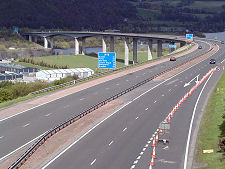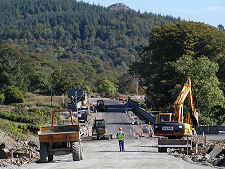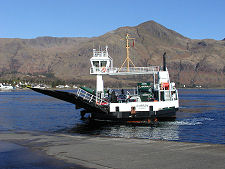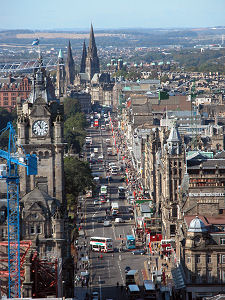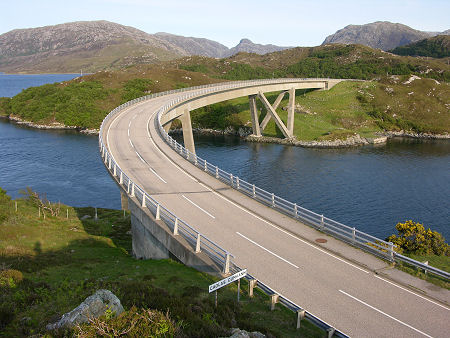 Beautiful Bridge, Empty Road, Beautiful Scenery: Driving in Scotland at its Best |
Many visitors to Scotland choose to get around the country by driving, either using their own cars, campers or motorcycles or hiring a vehicle on arrival. Scotland has a fairly good road network, with a total length of roads of just over 34,000 miles or about 55,000km. Of this total, about half are "unclassified", i.e. they are minor urban or rural roads; and around two thirds of all Scotland's roads are rural. The network of main through routes, or Trunk Roads, makes up just 6% of the total length of Scotland's roads, but carries around a third of all traffic.
What all this means in practice is that Scotland offers a mix of two very different sorts of motoring. With over half the population living in under a quarter of the land area, the Central Lowlands of Scotland, including the main cities of Glasgow and Edinburgh, offer a type of driving that will be very familiar to visitors from much of England and the more densely populated areas of Europe. Roads are generally good, but could be better, and routes into or out of the main cities can become very congested, especially during the morning and evening peak periods.
Much of the rest of Scotland is a different story. The Southern Uplands and the Highlands and Islands offer what is generally a much less crowded experience, though traffic levels can vary greatly between Summer and Winter in popular tourist areas, and it is worth remembering that for a lot of self-catering accommodation across Scotland, Saturday is "change-over" day, making it the busiest day of the week on many main roads.
Our tables of Distances by Road allows you to work out route lengths that can often be surprisingly long for such a small country. These tables don't, however, specify how long any given journey will take. Journey times obviously vary greatly depending on the type of road you are using, the amount of traffic, and your style of driving. But as a really rough average, we'd suggest that you should allow at least an hour for every 50 miles if travelling on the A1 or M74 from England to Edinburgh or Glasgow, and at least an hour for every 40 miles of travelling in most of the rest of Scotland, and for every 20-30 miles of travelling on single track roads. And if your destination is time-critical, for example you need to catch a particular ferry, add in an extra hour to start with, and perhaps an extra hour for every couple of hundred miles you are travelling in total.
As you drive through the more remote areas, sooner or later you'll find yourself on a road too narrow to pass the vehicles coming the other way towards you. Welcome to Scotland's single track roads. There are far fewer of these than there used to be, but quite a few still remain. With common sense and a mix of assertiveness and consideration, driving these is not as big a problem as it might seem to first-time visitors, and you can find out all you need to know on our Scotfax Feature on the subject.
Something else you need to watch out for on rural roads in Scotland are animals. Many roads in upland sheep-rearing areas are unfenced, and sheep have vanishingly little road sense: and even where there is a fence, sheep can still be on the road. The lambing season in Spring needs particular care. If you come across a sheep on one side of the road and a lamb on the other, you can guarantee that one will cross to join the other as you approach. But it's not just sheep: it's not uncommon to come across cattle or even goats on the road, and deer jumping out into the path of traffic from undergrowth or in woods cause many road accidents in Scotland.
An aspect of driving in Scotland that adds greatly to the enjoyment of the experience is the need to use vehicle ferries to reach many of the inhabited islands: and in places to link together parts of the mainland widely separated by long sea-lochs. Just remember to take notice of, and obey, the instructions from the crew when loading and unloading. And above all else remember to apply your handbrake for the crossing and, if you have any doubts about it, put your vehicle in gear as well.
Petrol stations are readily available across the whole of Scotland, and many, especially in the cities, are open 24/7. In more remote rural areas, petrol stations will still be there, but can be fewer and further between and fuel tends to be more expensive than in the cities. There is an increasing trend in popular rural areas for the provision of automatic fuel pumps that operate 24/7.
Drivers of electric vehicles will find there is a steadily improving level of provision of charging points throughout the country, provided by public bodies, commercial operators, accommodation providers and others. Heading off into remote rural areas might require more advance planning and, if you are wholly dependent on your batteries, is likely to induce greater range anxiety: but nowhere in the country should be considered unreachable in an EV.
Now a word abut the basics. In Scotland, like in the rest of the UK, we drive on the left side of the road. All roads have speed limits, even if they are not shown. Commonly indicated speed limits are 30mph (48kph), 40mph (64kph) or 50mph (80kph). At certain times of the day speed limits of 20mph (32kph) are in force around many schools. Elsewhere the speed limits for cars are as follows: 70mph (112kph) on motorways; 70mph (112kph) on dual carriageways; and 60mph (96kph) on other roads outside set speed limits: or 10mph less if you are towing a caravan. The limits are enforced by fixed position, mobile and average-speed cameras, and police patrols.
There are lots of roundabouts in Scotland, which will be a novel experience for some visitors. Unless otherwise indicated by signs or traffic lights, traffic wanting to join the roundabout should give way to traffic (which will usually be coming from your right) already on the roundabout.
Finally, anyone driving in Scotland needs to be aware of a few rules and regulations. Drinking and driving is heavily penalised, as is driving under the influence of drugs. In late 2014 the drink driving laws in Scotland were tightened further, so the blood alcohol limit here is considerably below the limit that applies in England. You can be prosecuted for using a hand-held mobile phone while driving: and smoking in any vehicle used for work (except a car) is also illegal. Smoking in a car carrying children under 18 years old is also illegal. It is compulsory for car drivers and passengers, in both front and in rear seats, to wear seat belts; and all children under 12 who are also under 135cm (4ft5in) tall must use a child seat suitable for their weight. If you are hiring a car, you should order child seats from the hire company when making the booking.


